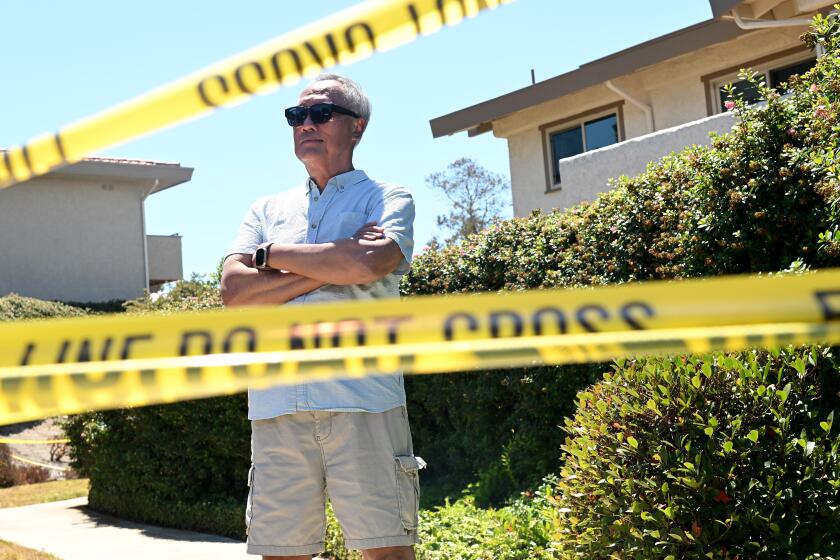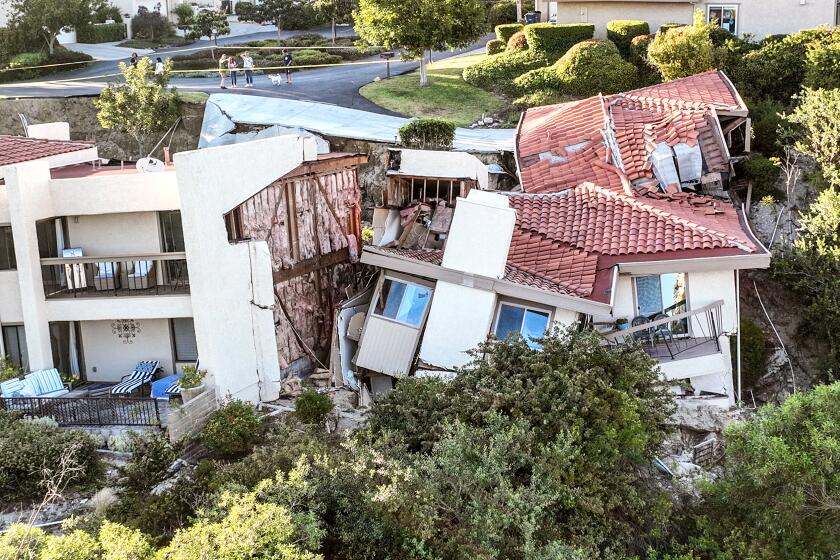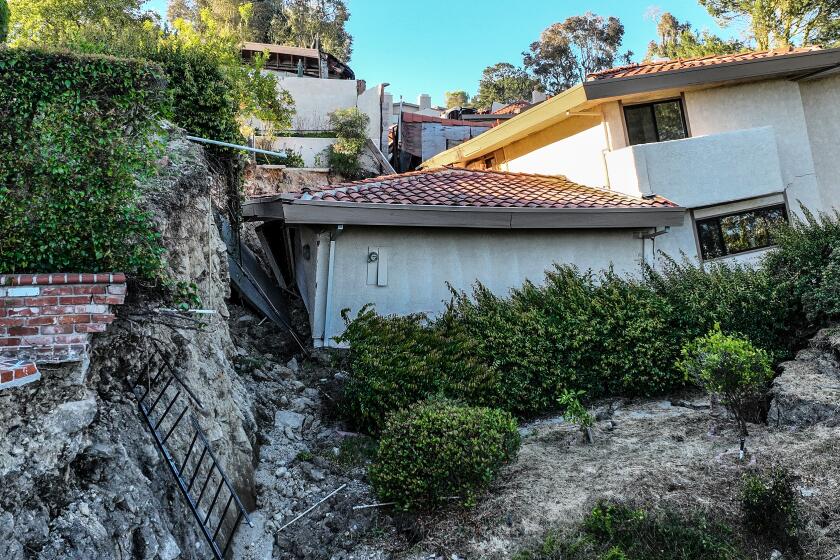Rolling Hills Estates landslide slows, but broken sewer line prompts more evacuations
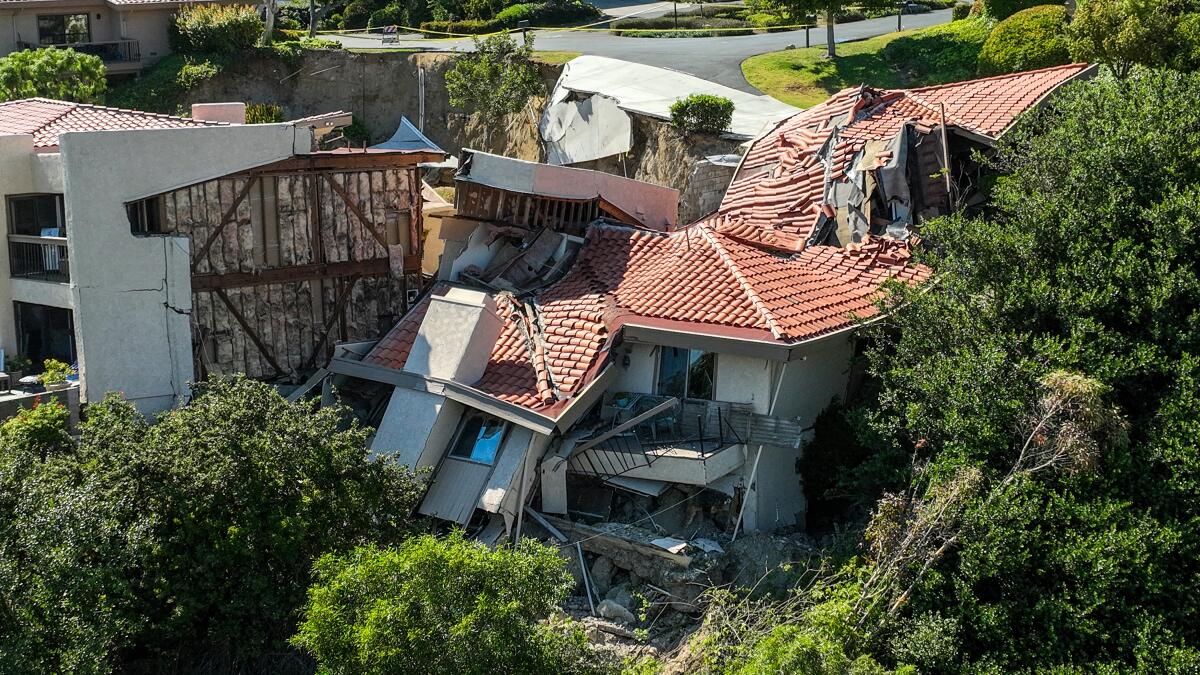
- Share via
Greg Brooks missed the knock at his Rolling Hills Estates home, which sits just a few yards from where multiple neighbors’ homes collapsed in a landslide this week.
Officials had warned Brooks that his family should be ready to evacuate, depending on how the landslide continued to move. So when he found the yellow tag at his front door Tuesday afternoon, warning of a sewer main break caused by the shifting land, he said he wasn’t too surprised.
“We’re hotel camping, which is OK,” Brooks, 64, said Wednesday morning. “I’ll just work around the situation as it goes.”
Brooks’ family is one of five new evacuations ordered on Peartree Lane, coming days after officials evacuated 12 nearby hilltop homes and deemed them unsafe for entry Saturday — one of which is the unit next door to Brooks’ duplex. At least eight of those homes have slid multiple feet down the side of the canyon they previously overlooked — their roofs caved in, walls split open and driveways left with an ominous drop-off.
The five newly evacuated homes have not been structurally damaged, officials said.
Just the roof of Weber ‘Wei’ Yen’s home is visible from his street in Rolling Hills Estates. He worries over the mementos he may never get back.
The cause of the landslide is still unknown. No one was injured in the collapse.
After days of ongoing shifting, Rolling Hills Estates officials said Wednesday afternoon that there’s been no additional land movement reported at the site since late Tuesday, when the shifting ground was described as slowing.
But the future of the site’s stability continues to nag residents and officials, and it’s unclear when answers might come. There has still been no geologist or soil expert out to the analyze the site, which Rolling Hills Estates Mayor Britt Huff said was becoming a worry.
“Everybody wants to know what happened,” Huff told The Times after the city’s council meeting Tuesday night.
The ground is still moving in Rolling Hills Estates, more than a day after 12 homes were evacuated because of major ground slides.
At that meeting, councilmembers voted unanimously to declare a state of emergency, which they hope will free up state and federal resources for the displaced residents, but it doesn’t appear to affect the process for getting landslide experts to the scene. The Rolling Hills Park Villas Homeowners Assn., which oversees Peartree Lane homes, is tasked with hiring the geologist, officials have said.
Huff said an association management team was in the process of “recruiting and hiring” such a specialist. But she said she knew little about the process and hoped to “throw city influence” to speed up the hire.
“It’s made everybody on the peninsula a little anxious,” Huff said of the landslide. Palos Verdes Peninsula has been long prone to landslides, which experts say can sometimes strike unexpectedly, especially in the case of a “deep-seated” slide, which is brought on by pressure from accumulating groundwater.
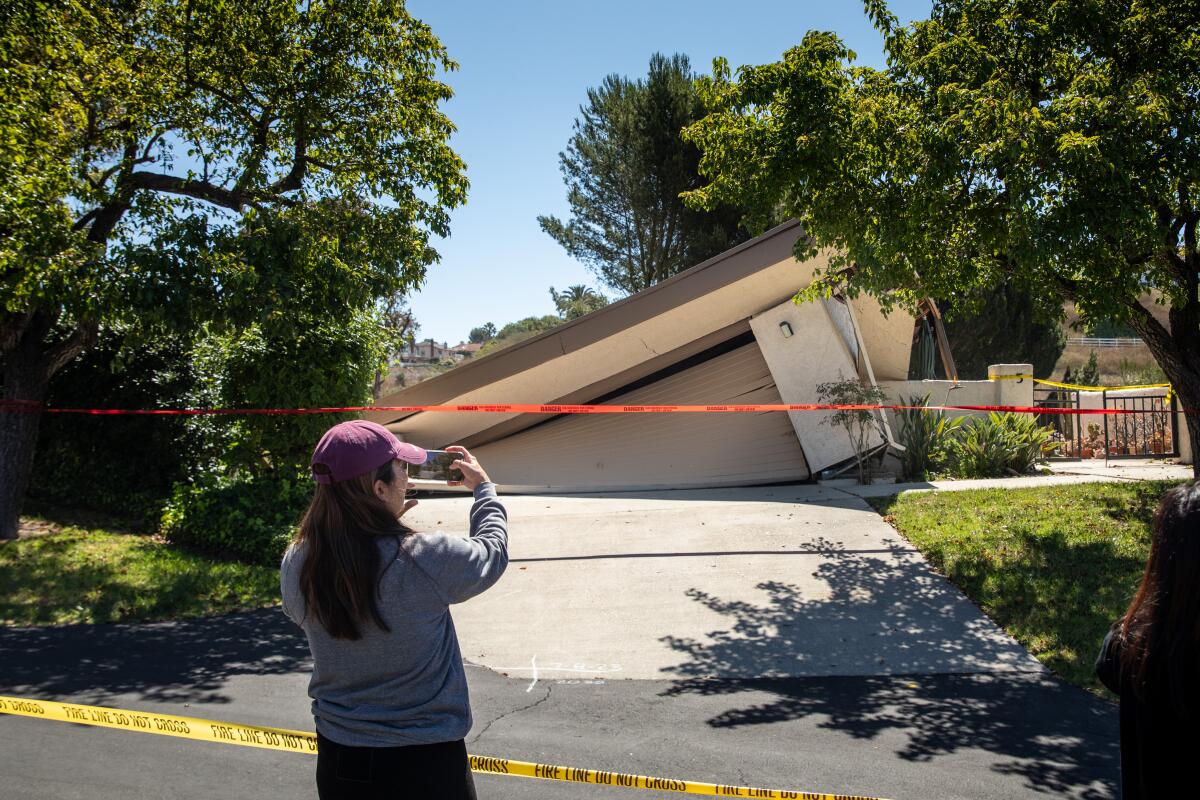
On Wednesday, L.A. County Supervisor Janice Hahn and Huff announced the creation of a $125,000 fund to “provide an option for temporary housing, food and other essentials for residents who have been ordered to evacuate their homes.”
Even though many homeowners are eager for answers, a thorough geologic evaluation takes time, said Ventura County geologist Jim O’Tousa.
“The first thing is public safety,” he said, “then evaluating the causes” of a slide.
Before visiting a site for assessment, geologists will typically try to find old aerial photographs of the area, ideally prior to development, to see if the neighborhood was built on a preexisting landslide. Google Earth may cover the past 20 years, but finding photos from before that can be more difficult. The homes on Peartree Lane were built in 1978.
Experts will also attempt to obtain records from the original land development as well as geologic maps, to extract information about the bedrock.
“Trying to find those old development records can take a couple of days to a week,” O’Tousa said. The goal is to model the terrain and decide “is this a piece of an old slide that was much bigger?”
After the research, a geologist looks for cracks upslope from where the homes have moved, and hikes down the hillside to look for seeping water, which can be an indicator of stability as the ground dries out, O’Tousa said.
Geologists will drill holes — called borings, usually 24 inches in diameter — to collect samples and look at the “subsurface geology,” including bedrock. The samples will undergo laboratory testing for “various strength parameters to model the conditions” and to help describe the geologic structure of the bedrock.
After the geotechnical evaluation, geologists will likely place measuring devices called slope inclinometers in the borings and in cracks “to help determine the rate of the movement,” O’Tousa said.
If the cracks are getting larger over time, that points to a “likelihood that the landslide will enlarge.” Conversely, if no movement is detected, it could be a sign that the hillside has stabilized.
In deep-seated landslides, future rainfall can continue to destabilize the hillside. O’Tousa worries that the Rolling Hills slide could be impacted by future weather, as well.
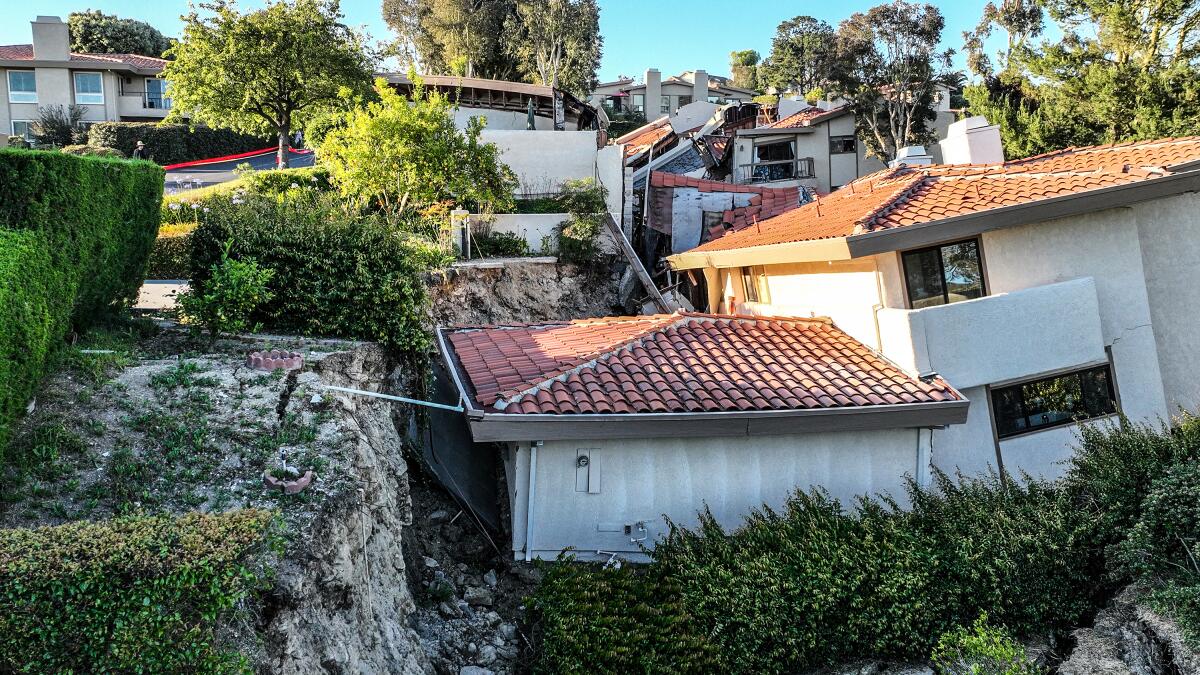
With everything facing his neighborhood and concern that it could keep getting worse, Brooks and his family — who are renters — decided to expedite their move from Peartree Lane. They had planned to leave their home of eight years at the end of the summer, but he’s now hoping to be out in a few days.
“Evacuate? I’m ready to move,” Brooks said. “All of these coincidences are telling us, ‘Go, get packed, run.’”
Brooks said he was told he can still access his home, even with it yellow-tagged, but no one can stay overnight without water access. He said he called the city early Wednesday hoping for an update on the sewer line fix but got no answers.
“She had no idea when it would be back up,” Brooks said. So for now, Brooks, his wife and his stepson are staying at a hotel in Torrance, thankful they aren’t dealing with the worst of the landslide.
Many of his neighbors had recently bought their homes and want to stay but worry about the future of the street.
“This is really bad for these people,” Brooks said.
As a Rolling Hills Estates hillside further collapses, homeowners without special coverage are unlikely to get any financial assistance from their home insurers.
Typically, homeowners insurance does not extend to landslides, save for a few subsets under other clauses in California.
Hahn said the landslide could have been caused by excessive rainfall in Southern California, raising an important question for an insurance claim: Does the Peartree Lane landslide fall under the force majeure clause, as an act of God, or was it foreseeable and could it have been prevented?
“We’ve seen homeowners in different areas of California that go after their homeowner’s association, because there might have been prior notice to damages,” attorney Jason Stone with the law firm Stone and Sallus said.
“There could be an argument that the HOA should have known of these risks,” Stone said.
Some residents have told The Times that they had previously alerted the HOA of cracking and other signs of potential land movement, but they said they don’t think anything was done.
The management company for the Rolling Hills Park Villas Homeowners Assn., Scott Management, as well as a member of the board, declined to comment or take questions from The Times.
More to Read
Sign up for Essential California
The most important California stories and recommendations in your inbox every morning.
You may occasionally receive promotional content from the Los Angeles Times.
